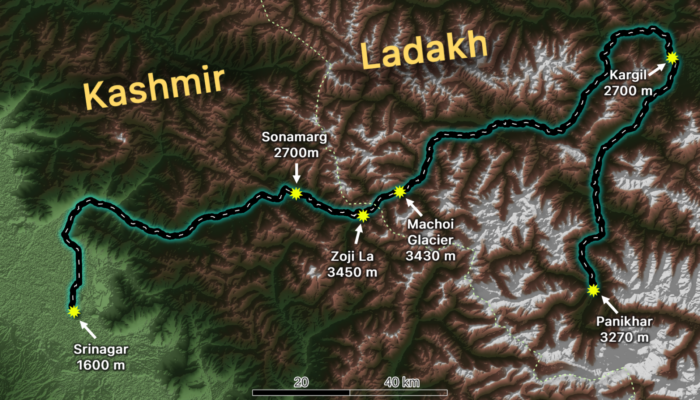
I am Krishnanand J, a graduate student in glaciology from IISER Pune, India. This is a story about my very first field trip to the Himalaya. Coming from a small village in Kerala, which is the southernmost state of India, going to the Himalaya is considered a big thing. It is like a camel visiting Antarctica. So below, I will take you along on an immersive journey, as I tell you about my first field trip to the Himalaya.
The Journey Begins ( Kerala, 900 m a.s.l.)
“You are going to Himalaya?!” exclaimed my family members and relatives with a tone which I couldn’t tell was concern, jealousy or excitement. “Are you planning to become a saint?!”- my mother asked jokingly. Himalaya has always been the top destination for great thinkers and religious founders of the subcontinent to attain enlightenment. The name “Himalaya” itself means “the abode of snow”, in Sanskrit language. Why was Himalaya special? I am not an expert in history or anything, but I have heard curious stories about the Himalaya since childhood. These ranged from stories of travellers finding the footsteps of Yeti (the abominable snowman), to stories about two-hundred-year-old Yogis meditating inside snow caves without any food or clothing. There has always been an element of magic and mystery around the Himalaya , which attracted me very much. Now being able to actually visit the place, my excitement was beyond words. It is fair to say, that I had already conquered great heights before I even landed in Srinagar airport, Kashmir, on the night of 19th August 2024. As we walked out of the airplane, we saw the sun setting behind the dark silhouette of the distant ranges of Himalaya.
Paradise on Earth (Srinagar, 1600 m a.s.l)
I was part of a team of 10 collaborators from four different Indian institutes, wanting to visit Panikhar village, in Kargil district of Ladakh, 200 km away from Srinagar. That meant a 7-hour road journey was waiting for us the next day.
We set out from our hotel the next morning in a tempo traveller. Through the windows, we could see pretty houses in the middle of huge farmlands, with misty mountains in the backdrop, and greenery everywhere. Kashmir is the kind of place where one could sleep for the entire day out in the open.
“Welcome to paradise on Earth!” read a large green signboard on the roadside as we passed some lotus fields. As we moved further east, the green mountains gradually became larger in scale and rockier in appearance, and their peaks started to glow brilliantly in white. As the mountains towered upon us from both sides, I realized that we were nothing but a round-off error when compared to its scale.

Kashmir in pictures: Night view of Dal Lake, and roadside view of Kashmir houses. (Credit, Krishnanand J)
At the sight of Machoi Glacier we stopped to click some pictures. This was the first glacier I had ever seen in my life: an enormous white chunk of ice sitting on top of brown-coloured mountain. It felt so out of place, as if a big hand had placed it there like the icing on a chocolate cake. By evening, we were so high up, that civilization appeared as small white dots through our windows in the valley below. “Last week one car fell down from here”, Shahid told us with a sinister smile, as we were going past a narrow cliffside road. Hearing that, I stopped enjoying the scenery, and started calculating in my mind which was the best window to jump out of in case our vehicle fell off the cliff.

As we neared the Zoji La, the scenery became more mountainous (left). A large herd
of sheep we encountered on the pass (right). (Credit, Krishnanand J)
Soon, as we crossed the Zoji la, the pass which connects Kashmir and Ladakh, the lush green valleys suddenly gave way to a much drier landscape. We had entered a rain shadow region of the Himalaya: Ladakh, one of the driest places in the world with less than 10 cm of annual rainfall. Glaciers are crucial for the villages present here as they almost entirely depend on glacier-fed rivers. Panikhar was one such village, where we were set to spend the night.
Climbing Higher! Expedition to Lamo glacier (Panikhar village 3270 m a.s.l.)
Panikhar village is located at the mouth of the Chalong river, which partly originates from Lamo glacier. Due to global warming this glacier is rapidly melting and retreating, leaving behind a glacial lake at its terminus. The lake has grown 20 times in size over the last three decades. The other side of the lake is dammed by a moraine. When the water pressure on the walls of the dam would exceed a threshold, the moraine would collapse, causing a glacial lake outburst flood (also read : this post about sikkim floods. We aimed to find out how large the flood would be when it reaches the village, and to suggest ways to minimise the impacts it would have on its people and infrastructure.

Overview map of the Panikhar village and the Lamo glacier lake. The melt waters of Lamo glacier merges with the Chelong river, which flows through the Panikhar village. The lake has been rapidly expanding for the last three decades, (shown in inset), which puts the village in danger of a potential outburst flood. (Credit: Krishnanand J)
After spending one day in the village for acclimatization, we headed towards Lamo glacier on the 21st of August. As there were no direct roads to the glacier, trekking was our only option, along with two porters from Panikhar (Illyas and Shoukat) and their five horses. The trek was not very difficult, but we had to do it for 5 hours. Moreover, the lower oxygen content at that elevation made me run out of breath faster. Hiking on, the valley slowly unfolded into probably the most beautiful scene of my life, almost as if rewarding us for all the struggles. An enormous meadow, with the Chalong river flowing through it as a hundred braided channels. Dozens of horses were grazing on these plains, as if in a scene from a fairy tale. Above that, we could see cross sections of massive tectonic folds on either sides of the valley. “This was a merging point of two glaciers to form a larger glacier in the distant past; a triple junction of U-shaped valleys,”- explained Aditya, the geologist in our team.

The most beautiful scene from the trip. We tried to capture this in camera but the sheer magnitude and beauty of the sight was so much that only human eyes could appreciate it. (Photo credits: Argha Banerjee, IISER Pune) (Credit: Krishnanand J).
Reaching the Heights! Camp site (3940 m a.s.l.)
After an hour-long walk, we stopped in a grass land. A fluffy black shepherd dog had stepped right in front of us. “Thou shall not pass” – he said. Paul offered some biscuits to him, and from that moment on, he became Paul’s dog. We set up a camp in a meadow roughly 1.5 km away from the Lamo glacier. Illyas and Shoukat set up a kitchen in the tent, complete with a gas stove and a pressure cooker with the additional benefit of keeping the inside of the tent warm and cozy despite outside temperatures of 8° C. Tired as we were, we crept into our sleeping bags and slept early that night. My sleep was disturbed by occasional high-pitched cries of Himalayan marmots. It seemed that Paul’s dog was not giving them any rest. These poor little creatures stood up and whistled to alert their friends whenever this vicious predator entered their territory. Next day when I woke up, Illyas and Shoukat had already prepared food for us. After breakfast, we set out to reach the Lamo glacier lake that morning.

Figure 7: The dog we met on the way, which later became friends with Paul (the human in the image) (Credit: Krishnanand J).
The Lamo Glacial Lake (4100 m a.s.l)
The turquoise-coloured lake was about 700 m wide, with broken chunks of ice as large as a single storey building floating on it. Without wasting any time, me along with Shahid, Burhan, and Aditya started measuring the water discharge at the glacial lake outlet. Pawan and Ravindra set-up the timelapse camera, which would look for any changes in the lake and the terminus of Lamo glacier for more than a year. During our experiments, Saurabh met with some nomadic shepherds who traditionally made a living by crossing a pass through the Lamo glacier to sell their goods in Kashmir. A few weeks back, one of their members had been lost to the lake while trying to cross the pass. Since the Lamo glacier lake was rapidly expanding, the pass was closing and their livelihoods were at risk.
“When would the pass heal?” they asked, to which we had no reply.
This story made us realise that climate change can affect us not only through direct natural disasters, but also though human tragedies-loss of livelihoods and its ripple effects on communities.

Figure 8: Lamo glacier and the glacial lake at its terminus. Ice chunks as large as a single storey building float in the lake after breaking off from the glacier. (Credit: Krishnanand J).
Return to civilization
It was the last night at the camp, so we sat near the tent just staring at the night sky. The atmosphere was so pristine that we could see the Milky Way with our bare eyes. I was really missing my ‘normal’ life back at home. The little things that we took for granted had become a luxury at the camp. To be able to make a phone call, access electricity and transportation, to eat whatever you like, to use toilets… the list was endless.
The next day, we all were craving to go back to civilization. But on our way back, we had a hurdle to overcome. Near the braided channels of Chelong river, we struggled to find a safe crossing. Luckily for us, Paul’s dog came to our rescue. He led us through a perfect path which was only known to him. When we reached back at Panikhar, we celebrated by singing songs.

Image of the night sky at the camp site. It is hard to see, but the faint brown patch in the centre is the Milky way. (Credit: Krishnanand J).
With that, this story has come to an end. I don’t know what the moral of this story is. It could be about how fruitful collaborations can be. It could be about the beauty of nature. Or it could be about the unexpected effects of climate change. There is an old Malayalam saying which pretty much sums up everything. “Namukku naame panivathu naakam; narakavum athuopole”– meaning, “It is we who built heavens for ourselves; the same applies for hell”

Paul’s dog helping us cross the freezing waters of Chelong river. (Photo credits: Pawan Singh, IIT Roorkee)
Further Reading
Can’t get enough of reading about fieldwork? Why not check out some of our other blogs!
- Quantifying the experience: Himalayan fieldwork in numbers
- Vernagtferner: My First Encounter with an Alpine Glacier
- Did you know? We can see what’s going on inside an ice shelf using geophysics!
- Women of Cryo VII: Making Fieldwork More Inclusive
Edited by Leah Sophie Muhle

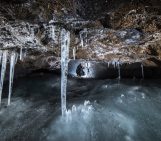
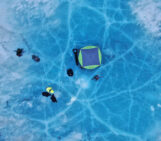
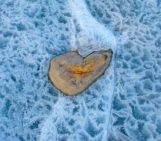
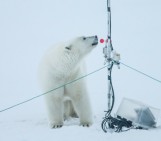
Irin
Good job!
Ghulam mehdi
At a distance of 10 km from panikhar the famous Nun kun peaks can seen & track from the main base Tangole village which have an another attractive features.
Imtiyaz A Malik
Excellent Research and articulation. I have been visiting there from last 12 years for research and I believe there is ample to be studied and worked upon.
Vikram
Had been here in August of this year !! This is not the only glacier lake here , once you cross the moraine field beyond the glacier and climb up the Lomvilad pass , you get another glacier that is rapidly melting and forming a lake. Great read, thanks for the information
Vandan
What a lovely read. It brought back memories of my times in Ladakh. Can’t wait to go back!
Seeret Farima
Thank you for your great information about my area sir,👍